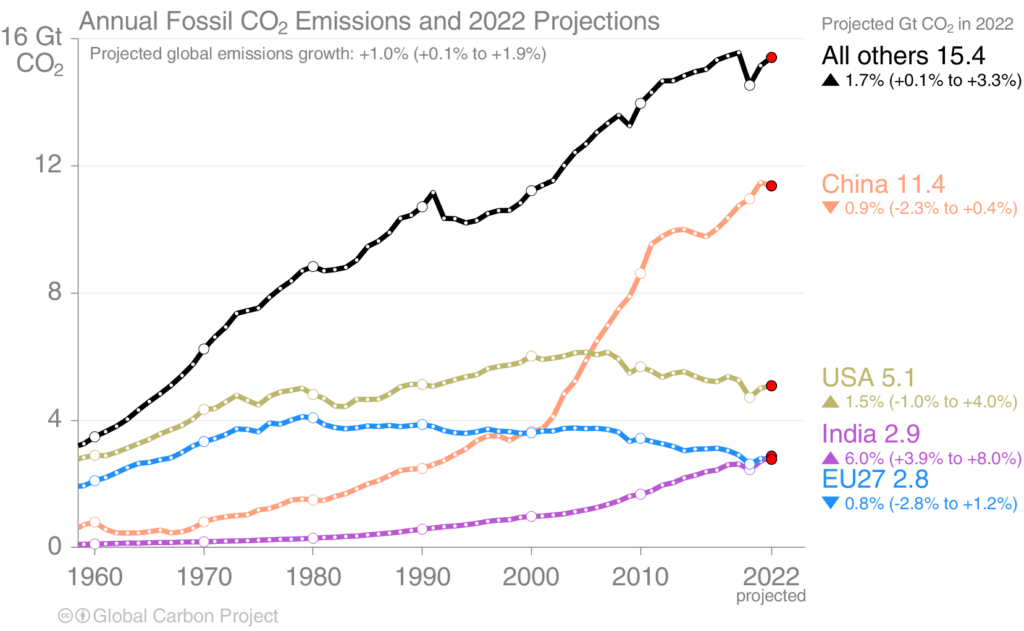
2023 Doomsday Clock Statement
Science and Security Board
Bulletin of the Atomic Scientists
https://thebulletin.org/doomsday-clock/current-time/
On the bright side, this group is completely out to lunch in using the threat of the fake climate crisis to move the clock closer to midnight.
Life on this planet is begging for MORE CO2!
During the current climate optimum for most life, the planet is GREENING UP and we have a booming biosphere.
The scientifically proven optimal level of CO2 for plants and most life (animals that eat plants) is double the current level in the atmosphere.
It was this warm 1,000 years ago, during the Medieval WARM Period that was wiped out of history and it was warmer than this during the Holocene climate OPTIMUM from 9,000 to 5,000 years ago.
Death by Greening:
https://www.marketforum.com/forum/topic/69258/
Unlike that fake crisis using junk science, the war in Ukraine is real and nuclear weapons are real.
So that threat is legit.
+++++++++++++++
Do you recognize a serious problem with the graphs below and what they are stating and what they
want the US and EU to do(go back to pre Industrial age energy poverty)?
CO2 is well mixed in the global atmosphere!
https://thebulletin.org/doomsday-clock/current-time/climate-change/

https://www.marketforum.com/forum/topic/92155/
Figure 2. Average annual climate-related (blue line) and non-climate-related (red line) deaths in natural disasters. Data from OFDA/CRED International Disaster Database

Rather than simply presenting integrated streams of battlefield data, AI systems are developing the capability to make independent targeting decisions without human input. This is where major problems can arise. As Arthur Holland Michel writes for the United Nations Institute for Disarmament Research, battlefield environments are “harsh, dynamic, and adversarial.” Under these circumstances, autonomous systems are bound to face problems and could potentially “fail in a complex and unpredictable manner.”
Despite these risks, Ukraine’s digital transformation minister, Mykhailo Fedorov, has indicated that Ukraine has been conducting “a lot of R&D” to develop fully autonomous killer drones, declaring that these systems are “a logical and inevitable next step” in weapons development. Russian forces also may be close to deploying autonomous drones, with officials claiming that the Lancet drone “can operate with full autonomy.” As leading AI researcher Stuart Russell notes, “the technology is not especially complicated,” positing that within a semester, a team of graduate students could build an autonomous drone “capable of finding and killing an individual, let’s say, inside a building.”
The long-term spillover effects are troubling. Other actors, such as Iran and Turkey, already possess impressive technological military capabilities, and they are paying close attention to their drones’ military effectiveness on the Ukrainian battlefield. If more and more states become convinced that autonomous drones hold the key to the future of warfare, they will be motivated to pour resources into the development and deployment of such technologies.
Related analysis from Carnegie
Due to the “open technological revolution,” in which the provenance of innovation has shifted from government agencies to private commercial firms, a wide group of countries can acquire advanced tools for a variety of uses, whether enhancing their internal security or increasing their warfighting capabilities. One has to assume that AI battlefield tools will proliferate widely and efforts to establish ethical and normative guardrails will fall behind the pace of innovation, increasing the risk that military applications of emerging technology will spiral out of control.
The Ukraine war demonstrates the grave human costs when military imperatives override humanitarian concerns and outpace ethical consensus. Alarmed by escalatory threats in that conflict, in January, the Bulletin of the Atomic Scientists moved the Doomsday Clock forward to ninety seconds to midnight—the closest to global catastrophe the clock has ever been. This should be a wake-up call to political leaders about the imperative to confront threats emanating from Russia’s rogue behavior—and to mitigate risks posed by lethal emerging technologies—before it becomes too late to reverse disaster.
See more of Carnegie’s coverage of the Ukraine war’s long shadow.
https://www.zenadrone.com/drones-impact-the-future-of-military-warfare/
Drones provide real-time information on targets’ positions, terrain, and enemy movements to commanders on the ground. Compared to high-altitude aircraft, drones can take closer footage without compromising the quality of both photos and video.
Drones are cheaper than conventional aircraft in terms of both price and maintenance. Because drones are unmanned, they also reduce the risk of pilots being injured mid-flight.
Compared to conventional aircraft, drones are faster and easier to deploy. They are easier to operate and don’t need training as extensive as most aircraft. Also, many drones don’t need a runway, and other types can easily fit in a backpack.
Drone operators can provide real-time information without putting themselves at risk. On top of this, that same information also informs commanders where to position their troops to ensure safety.
Military forces always need to be ready for anything at a moment’s notice. While the military-industrial complex has developed technology that prioritizes this need, drones are the best example. On top of this, drones can even be fully automated.
Today, many Military Warfare industries develop drone technology integrated into more military programs worldwide. They provide many benefits and advantages that make them extremely useful for different roles.
As a result, more military forces are looking to use drones to increase their combat and surveillance capacity. These are the most common roles UAVs fulfil:
Since its initial development by the military-industrial complex in Cold War times, drones have come a long way. Unmanned aerial vehicles are increasingly common, seeing more applications outside of combat.
In civilian and commercial applications, their functions will only become more sophisticated. Here are some of the things they can already do:
ZenaDrone is one such drone that has these capabilities and more. It combines the best of both software and hardware to provide solutions for aerial monitoring and data gathering. The result is a valuable asset capable of fulfilling needs in various industries.
To see ZenaDrone in action, schedule a demowith us today!